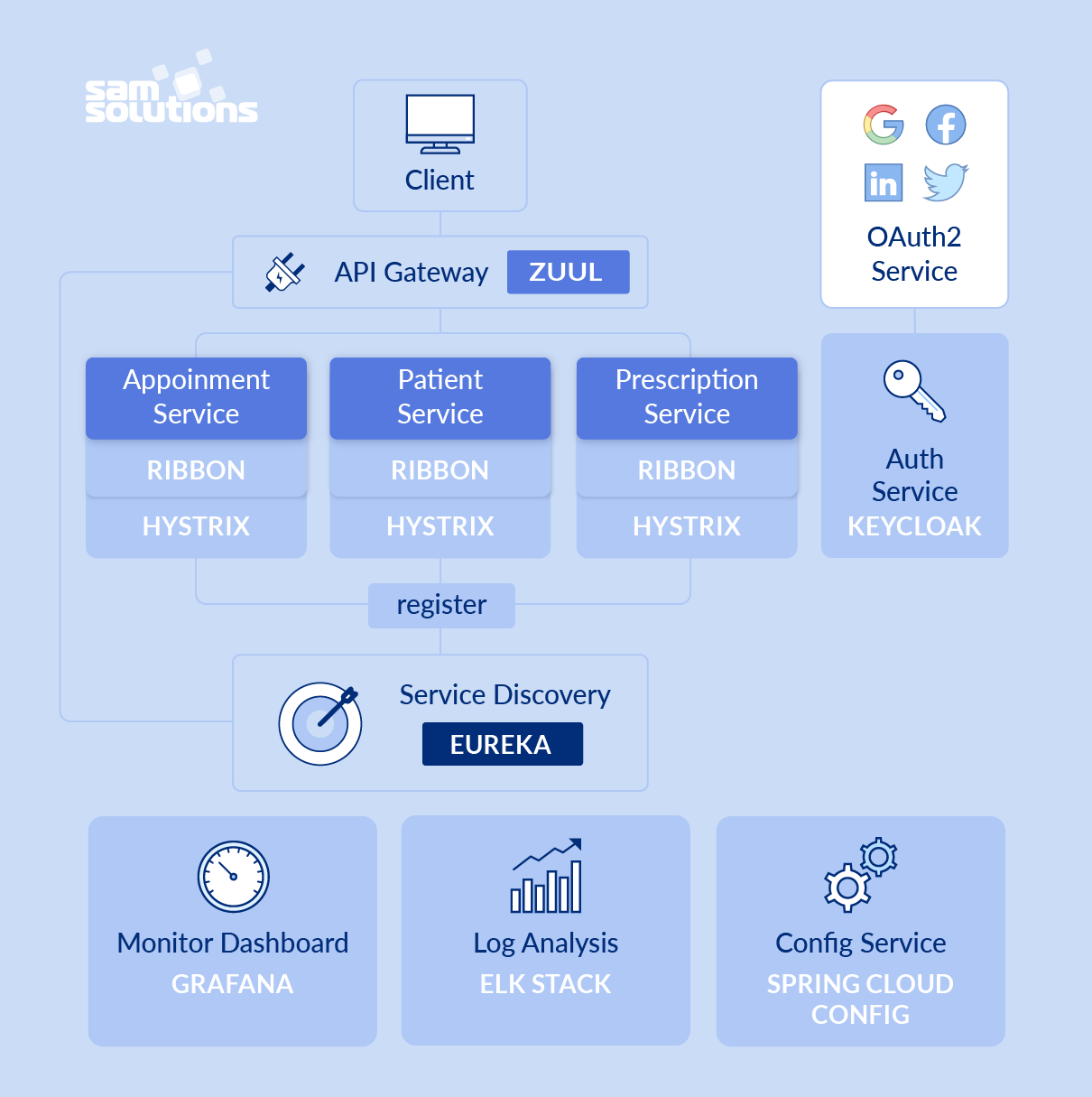Microservices architecture implementation is a new approach to software development, and it has been mesmerizing a growing number of businesses. These companies abandon a conventional monolithic application architecture in favor of a new structure that is based on a collection of multiple loosely coupled services. This innovative approach to application development has already provided dozens of companies with valuable benefits, with enhanced flexibility and time-effectiveness in the spotlight, helping them enhance their businesses. Let’s get to know them!
We develop highly custom software solutions across all technologies and industries – receive a free consultation today
“Making decisions in system design is all about trade-offs, and microservices architecture gives us lots of trade-offs to make,” independent consultant Sam Newman said in his book, Building Microservices.
The Basics of a Microservices Architecture
The term “microservices architecture” was first coined in 2011 to describe a pioneering software development architecture that was expected to challenge a traditional approach that rests on a structure’s atomicity. A variation on the service-oriented architecture, a microservices architecture submits an application as the integration of numerous small services that are loosely coupled together.
To this day, the term does not have a clear-cut definition, but its hallmarks are clearly stated, including:
- The modular structure that comprises a number of separate micro-grained services
- Each of the microservices runs its unique process and manages its own database
- Services communicate via lean application protocols
- All of the microservices have a standard web service interface, allowing them to communicate and iterate seamlessly
- Services are scalable; each has a specific business value and customer-oriented goals
This modular structure streamlines building systems with microservices architectures and their testing, as it implies that numerous development teams create, deploy, scale and verify software simultaneously and independently. Amazon has named these groups of six to eight developers “two-pizza teams,” as two pizzas are enough to feed them.
Naturally, these microservices teams are a little bit different from conventional development departments. For example, each team has complete ownership of one or more microservices throughout its/their entire lifecycle. This means that team members communicate with customers to design required feature s, develop them, test and deploy.
Also, these people are responsible for issues in a piece of code that they develop. That is why none other than the members of a respective group fix the errors that they have made. This responsibility is an incentive that significantly contributes to the enhanced commitment and improved software quality.
In a way, this approach is in the mold of the DevOps-based software building process, as a microservices team also merges development and operational experts. These engineering teams create, modify and manage independently versioned pieces of software that can be put into production solo.
The Benefits of Microservices Architecture for Enterprises

Within a short time that companies have been implementing the microservices architectural model, it has proved to have clear-cut advantages over a traditional monolith structure. Along with a high business value of microservices, this approach has certain drawbacks that influence the development process, such as:
- The development of separate microservices takes longer as compared to the creation of a monolithic application
- The development process is more complex than that of an application with conventional architecture, as this software encapsulates a complex of independent services and different development teams create them
- The coordination of separated microservices is sophisticated and resource-intensive as they sum up multiple virtual machines and their cooperation hinges upon a network
- The maintenance of this module -based application is challenging as it entails separate maintenance of its every piece
All of these drawbacks may result in an increased time to market and may reduce a company’s market share. However, the advantages that microservices architecture implementation provides for business es definitely cancel out and exceed these disadvantages.
Read also: Microservices vs. Monolithic Architecture Comparison
Software Reliability and Safety
A microservices-based application structure implies that every software falls into numerous independent services, and developers manage each of them on an individual basis. While it may seem that this approach induces the lack of coordination among free-standing services, their isolation brings about a much more substantial advantage. Different services do not intercross during the development process, which means that a possible error or a bug will not infiltrate into other pieces of application code.
Architecture modularity results in limiting the scope of a defective service to the area where a possible aberration may arise. If one of the software features fails, the entire application keeps running. Concurrently, a development team that was involved in its creation fixes bugs and seamlessly puts software into production. That is why an error in software performance does not cause its downtime or any significant inconvenience to users.
This also concerns security incidents. As different features are separated, a piece of software that behaves maliciously can be handled in a time-effective manner, while other features stay untouched.
Consequently, this architecture enhances an application’s failure tolerance, which in turn brings about improved customer experience and a strong business reputation. Also, this structure eliminates the risk of loss of important corporate data or downtime for the period when an application does not work or functions poorly.
Time-Effective Releases
An improved pace of the delivery of new features is a key success factor in highly competitive markets, as it allows leaving competitors’ offerings behind. A software architecture that comprises multiple services allows for quick updating and modification to meet current market and user requirements.
This is because the development team does not need to revise the whole application, they only need to update or modify a target service. Adopting a microservice architecture allows releasing new features in a more cost-effective manner than a monolithic architecture.
Enhanced Software Flexibility
A modular software structure stipulates that separate services can undergo a comprehensive modification, and services can be added without affecting the entire application. That is why the benefits of microservices include high software flexibility that shows itself in several ways.
The ease of modification. Each of the services is in charge of its specific business-oriented tasks, which is why the updating of one feature does not affect other functionality. After developers have modified a service, they can redeploy it. This works the same for new features, as they can be added seamlessly and without affecting the whole application performance.
A brilliant example here is Booking.com with its software built on the basis of a wide number of microservices. This structure is the only way to enable its trouble-proof performance as it eliminates interdependency among its various features. A part that is the most commonly used – a searching facility – is also developed as an independent service to keep software functional in case of possible aberrations.
The ease of feature enhancement. Microservices architecture provides the possibility of freely developing and then deploying new features to an existing application. This ensures that modifications will not degrade or slow down the performance of the whole application after they have been introduced. However, it enhances the flexibility to provide a positive customer experience and helps a company stand out.
High scalability. As opposed to the monolithic software architecture, a microservices-based one significantly enhances software scalability. Different services can be deployed on a number of servers, which minimizes the risk that services will contact and affect one another and improves their performance. Also, the software can be easily expanded or shrunk in accordance with changing business requirements.
Language-, technology – and framework-polyglotism. Multiservices do not bind developers down to using one and the same technology stack throughout a project. Teams can apply new frameworks, languages, tools and technologies as often as required, and this will not affect software functionality. It is much easier than in the case of a monolithic application structure, as the later stipulates stronger dependencies. Actually, a microservices-based structure demonstrates that the flexibility to adopt a new technology stack increases as the amount of code decreases.
Read also: BizDevOps and DevOps Implementation
Cost-Effective Software Modification
While the development of a microservices-based application is more expensive than that of a monolithic one, this principle works quite the opposite in the case of software modification. Indeed, a modular structure allows for changing specific features without rewriting the code of the whole application. That is why the more fine-grained microservices are, the cheaper it is to make changes. If developers need to modify a small piece of code, it will require little effort, and, consequently, a small number of man-hours.
Real-World Use Cases of a Microservices Architecture
Despite the fact that this software structure is quite new, it has won a lot of businesses, and giants such as Amazon, Walmart, Netflix, Google, Booking.com and Twitter have built a microservice architecture. All of these booming businesses are the best evidence of the efficiency of microservices for the enterprise.
Amazon
In 2001, when Amazon.com started up, it was developed as a monolith, like the overwhelming majority of newborn companies. Actually, it contained numerous multi-component tiers, but their close cooperation made this retail website perform as a real monolith. Although this type of website structure did not have apparent defects, over time, Amazon faced the complexity of coordinating multiple changes.
Despite the fact that each developer worked on a specific piece of code, the management of changes that they performed was a real challenge. Indeed, every modification, updating or bugfix in this huge system required developers to cooperate. This allowed team members to be sure that a change will not damage the entire code or that all developers make simultaneous updating, which has brought about merge days. Along with this, the whole website’s codebase was becoming outdated and required rebuilding.
Eventually, the company divided the code into functional units according to their purpose, provided them with the same web service interface and enabled their communication via web service APIs exclusively. This resulted in a microservices architecture implementation, which allowed services to function independently. Also, the company has reduced the size of teams to six to eight members (the two-pizza teams) and has given them complete ownership of respective services.
These changes in the company’s frontend development have factored in significant positive improvements. This enabled development teams to independently fix bugs, make modifications to the code and crank out required functionality. Now, the microservices architecture of Amazon’s website allows the company to make about 50 million deployments per year.
Walmart
Walmart Canada turned to a microservices architecture after its website failed on Black Fridays for two years in a row. The problem has arisen because it could not sustain six million page views a minute, which resulted in negative user experience and lost sales. Losses that were equal to millions of dollars became the reason that compelled the company to revise its IT system.
That is why the company arrived at a decision to replatform the legacy architecture to provide website scalability in line with a growing number of users and resistance to a heavy load. Along with the preparation for occasional stress load, the company required to get the system ready for the internet of the future, which means a much higher load and an increased number of connected devices.
Microservices architecture has become a spot-on solution, as it allowed to achieve a trouble-proof website performance under both a regular and heavy load, alongside with significant savings and increased conversion.
Break a Monolith into Microservices
Numerous microservices-related success stories provide evidence that this modular application structure delivers valuable benefits to companies’ IT systems and to their business operations at large.
We’ve been developing custom software solutions for SMBs and enterprises for over 30 years
SaM Solutions also adheres to this architectural model as the company has been witnessing how its customers succeeded from dividing software into small sections. SaM Solutions’ enterprise microservice development experience has proven that microservices have multiple advantages over a monolithic structure. Indeed, a division into fine-grained pieces allows improving software functionality and performance in a time- and cost-effective manner. Also, a modular structure of an application encourages its high scalability and the ability to address increased load in a failure-proof way.



























 5 Reasons Why Your Business Needs a Mobile eCommerce Application
5 Reasons Why Your Business Needs a Mobile eCommerce Application Using Salesforce to Improve Your Sales Pipeline: Five Tips
Using Salesforce to Improve Your Sales Pipeline: Five Tips Cross-Platform Mobile Development: Five Best Frameworks
Cross-Platform Mobile Development: Five Best Frameworks How to Develop Custom Accounting Software
How to Develop Custom Accounting Software 10 Best Web Development Frameworks in 2024
10 Best Web Development Frameworks in 2024











